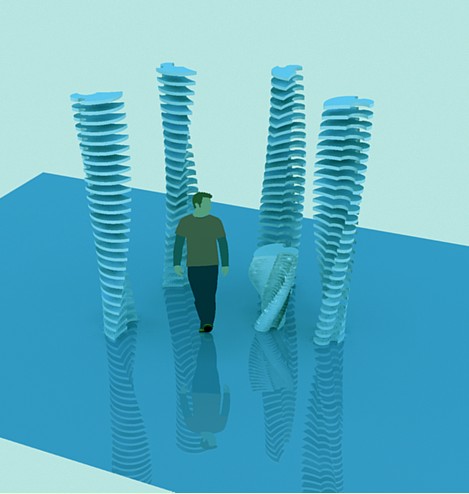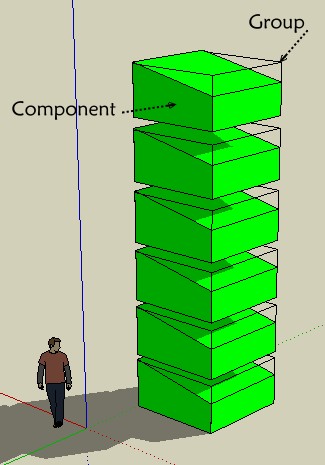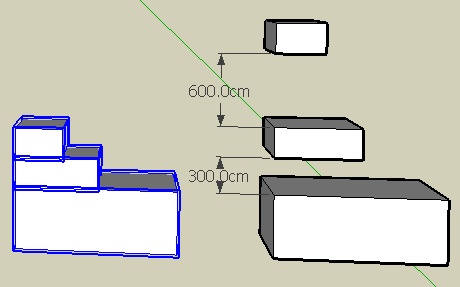Move groups with different measures?
-
So i must use the Tig Advertissement more soon than I have expected

-
This group.bounds.min.z. can be found somewhere or the sorting of Groups must be forged again?
(nothing about sort, sorting in the API helping)
-
Build a hash with the entities as the key and their Z posiiton as value and then sort the hash by the values.
-
Each groups has not a "time creation" trace board? So no need to remake a sorting ?
Seems I have re-open a new nightmare door
-
Awesome Pilou! Keep it up, its looking great. You've got lots of good help around here.
Chris
-
Try something like...
zeds=[] index=0 groups.each{|group| zeds.push(group.bounds.min.z, index) index+=1 } zeds.sort! sorted_groups=[] zeds.each{|z|sorted_groups.push(groups[z[1]]) } ### sorted_groups is now groups sorted by Z -
Does the group.bounds.min.z only valuable in SU 7?
Edit seems not
little try but seems I miss something
 (any doubt selection but the sorted_groups gives nothing on the screen)
(any doubt selection but the sorted_groups gives nothing on the screen)model = Sketchup.active_model entities = model.entities selection = model.selection groups = [] z=0 zeds=[] index=0 groups.each{|group| zeds.push(group.bounds.min.z, index) index+=1 } zeds.sort! sorted_groups=[] zeds.each{|z|sorted_groups.push(groups[z[1]]) } ### sorted_groups is now groups sorted by Z sorted_groups.each do |e| point = Geom;;Point3d.new 0,0,z t = Geom;;Transformation.new point e.transform!(t) z = z + 1000.mm end -
it's like a snowball on the top of the mountain


-
groups = [] then nothing set !!!
You emptied the groups array...
You need to fill it from the selection...
groups=[];selection.each{|entity|groups.push(entity) if entity.kind_of?(Sketchup;;Group)} -
another try found: undefined method ‘[]’

model = Sketchup.active_model entities = model.entities selection = model.selection z=0 zeds=[] index=0 sorted_groups=[] groups=[];selection.each{|entity|groups.push(entity) if entity.kind_of?(Sketchup;;Group)} groups.each{|group|zeds.push(group.bounds.min.z, index) index+=1 } zeds.sort! zeds.each{|z|sorted_groups.push(groups[z[1]]) } ### sorted_groups is now groups sorted by sorted_groups.each do |e| # update! # Now we process the groups point = Geom;;Point3d.new 0,0,z t = Geom;;Transformation.new point # Apply the transformation e.transform!(t) z = z + 100.cm end -
Is that the only error message you get?
@unknownuser said:
it's like a snowball on the top of the mountain

You're hooked now! No way back!


-
Here's some tweaked code
def test() model = Sketchup.active_model model.start_operation("Move in Z") entities = model.entities selection = model.selection zeds=[] index=0 sorted_groups=[] groups=[];selection.each{|entity|groups.push(entity) if entity.kind_of?(Sketchup;;Group)} groups.each{|group|zeds.push([group.bounds.min.z, index]) index+=1 } zeds.sort! zeds.each{|z|sorted_groups.push(groups[z[1]]) } ### sorted_groups is now groups sorted by z = 0.0 sorted_groups.each do |e| # update! # Now we process the groups t = Geom;;Transformation.new(Geom;;Point3d.new(0,0,z)) # Apply the transformation e.transform!(t) z = z + 100.cm end model.commit_operation return nil end#defRuns as '
test'.
I made a typo - it needed an array[]of two items adding tozeds: zeds.push([group.bounds.min.z, index])not two 'loose' items as inzeds.push(group.bounds.min.z, index).
I made yourz = 0intoz = 0.0as it needs the number as a float, not an integer...
Removed 'point' variable and set the point definition directly inside the transformation - not necessary but fewer variables...
I added amodel.start_operation("")...model.commit_operationso it becomes a one step undo.
I addedreturn nilat end so the Ruby-Console doesn't get clogged with info...Tested it - it works...
-
Seems indeed that some corrections were necessary

This time works like a charm! Excellent! TIG + Thomthom! Bravo!
I will see all that more in detail for learn this little cryptic language !
Very funny plug!
For the next Pilou's foolish...
...I need to know the "centroïd" (xyz) of a "bounding box's group"
Here of course without different measure, just for little test! (click image)
(click image)

-
@unknownuser said:
...I need to know the "centroïd" (xyz) of a "bounding box's group"
centre_point=group.bounds.centerSee http://code.google.com/apis/sketchup/docs/ for all these details

-
Thx I had missed this one

-
It'd help if you posted the error messages.
However, I can still see the problem here.
Sketchup::Componentisn't an SU object. Check the manual, you haveSketchup::ComponentDefinitionandSketchup::ComponentInstance. In your case you're looking for aSketchup::ComponentInstance. -
I have replaced "Group" by "Component" but seems that is not so simple

groups=[];selection.each{|entity|groups.push(entity) if entity.kind_of?(Sketchup;;Component)} groups.each{|component|zeds.push([component.bounds.min.z, index])Else I can yet nest a component inside a group color transparent

That works fine (just disable Edges visible) but I suppose there is another thing

-
@ Tig Some cryptic but I will see that

Joint an image for no ambiguities
So here the increment is 300 cm
Edit sorry I have not seen all these speedy results!
@Thomthom! Yes that is that ! e.transform!(t)


-
Come back in these very dangerous territories

As I understand that retrieve the center XYZ of the bounding box group by
center = boundbox.centerbut how give these 3 values(?) to these 3 variables ?

xc= ?
yc= ?
zc= ?
must be trivial but yet some foggy for me
PS I read the API from the end to the start, and inverse but this stay mysterious found anything except that
-
boundbox.centerreturns an object of typePoint3d. You can check what an object is by checking the.classvalue of an object. That gives you an indication to where to look.xc= boundbox.center.x yc= boundbox.center.y zc= boundbox.center.z
Advertisement







